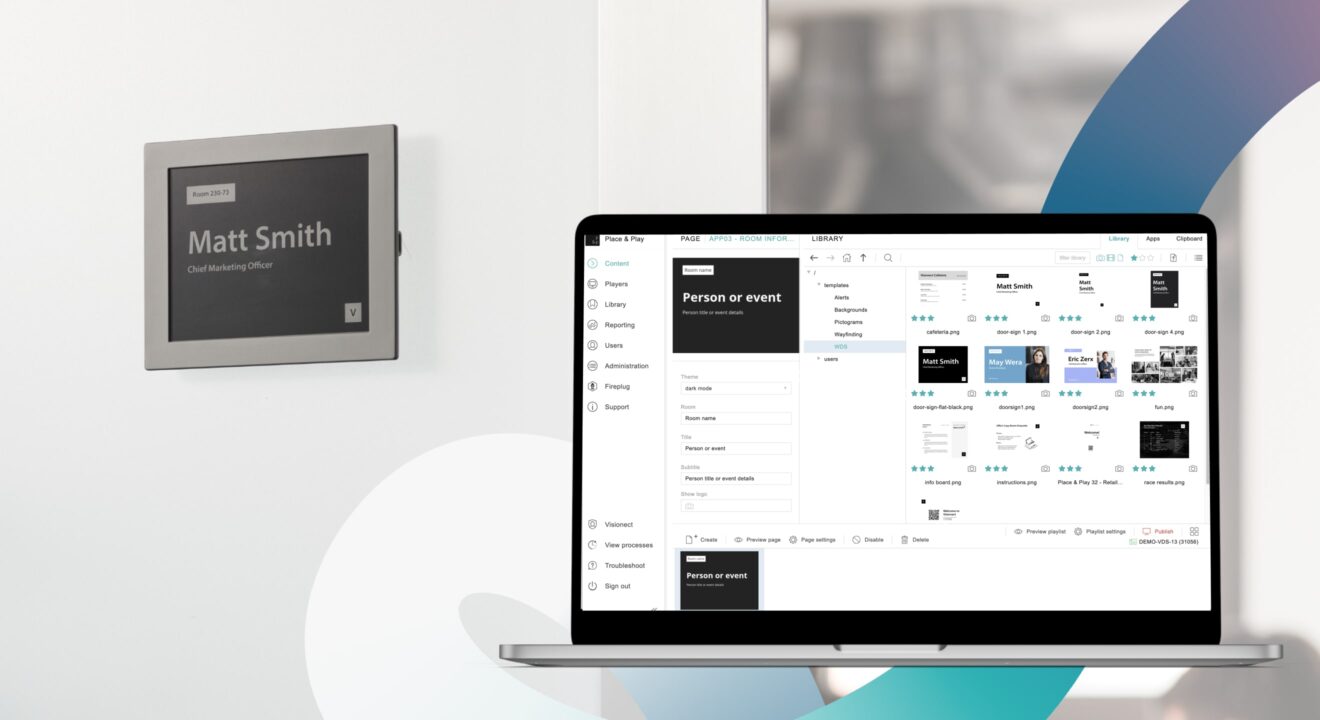

What is a Content Management System (CMS)?
Visionect, 9 Sep 2025
In simple terms, a Content Management System (CMS) is software that lets organizations create, manage, and distribute digital content without needing deep technical expertise. The platform provides a central hub where users can upload media files (images, videos, documents, etc.) and publish them to various channels.
While many CMS tools are known for managing websites, the same principles apply to digital signage. For a signage network, the CMS is the “lifeblood” of the system: nothing shows on the screens without it. Essentially, a digital signage CMS is a platform that lets you design, schedule, and push content (like menus, ads, wayfinding, announcements) to one or many display screens from a single interface.
How a digital signage CMS works
Digital signage networks in offices, museums, educational facilities, and retail venues rely on a CMS to handle all on-screen content. In practice, you log into the CMS dashboard (often web-based) to upload files from your computer or cloud storage and organize them into layouts and playlists.
The CMS lets you specify exactly when and where each message appears. For example, you might schedule breakfast menus to show each morning, switch to lunch specials at noon, or display targeted ads in the afternoon. This way, you control the content on every display remotely without ever needing to swap USB sticks on each screen.
Core functions & benefits of a digital signage CMS
A digital signage CMS goes far beyond basic file storage. It serves as the central hub that keeps screens dynamic, consistent, and impactful. The platform combines tools for scheduling, content design, remote publishing, and monitoring with business benefits such as brand consistency, targeted messaging, and operational efficiency. In many ways, the CMS functions as the backbone of a professional signage network.
Media library & organization
The CMS provides a centralized library where images, videos, documents, and even live feeds are stored securely in the cloud. This repository not only keeps assets organized but also makes them accessible from anywhere. Marketing and IT teams can easily reuse content across campaigns, saving time and reducing duplication.
Content design & branding
Many CMS platforms include built-in design tools or integrations. These tools allow your team to design polished layouts directly in the system while maintaining consistent branding. Every screen in your network can reflect your brand’s colors, fonts, and tone of voice without requiring external designers.
Playlists, layouts & scheduling
One of the most powerful features is the ability to create playlists or multi-zone layouts and schedule them to play at specific times. You can design screens that display different types of content side by side. For example, a news strip alongside a rotating image gallery. Scheduling tools also allow you to set rules, like showing breakfast menus in the morning and switching automatically to lunch at noon, or updating promotions based on the weather.
Remote publishing & updates
Because most modern signage CMS platforms are cloud-based, updating content is as simple as logging in from your browser. Forget manually updating each screen, a change made in the dashboard can be pushed instantly to every display in your network, no matter where it’s located. This flexibility is especially valuable for multi-location businesses that need to maintain consistency across hundreds or even thousands of screens.
Monitoring, reporting & analytics
Modern digital signage CMS platforms provide a clear overview of your network, allowing administrators to track which displays are online and verify that scheduled content is playing correctly. Many systems also include reporting features that help identify technical issues and make sure content is delivered smoothly across all screens.
Real-World Use Cases for a Digital Signage CMS
To understand the true value of a digital signage CMS, it helps to see how organizations apply it in practice. Industries, businesses, and institutions are using CMS-powered signage to communicate more effectively, engage audiences, and improve efficiency.
Museums
Museums use digital signage CMS platforms to create immersive visitor experiences. Displays can share exhibit information, highlight upcoming events, or provide interactive wayfinding. Content can be scheduled to match visiting hours or special tours, helping museums engage audiences and tell stories dynamically.
Corporate offices
In workplace environments, digital signage helps streamline internal communication. A CMS makes it easy to share company announcements, HR updates, or performance dashboards across departments. For global organizations, content can be tailored by region or language, helping the right message reach the right employees.
Healthcare
Hospitals and clinics rely on digital signage to share wait times, direct patients to the right departments, and broadcast wellness campaigns. Because updates can be pushed instantly, the CMS allows healthcare providers to keep information accurate and reduce stress for visitors.
Education
Universities and schools use CMS-driven signage for wayfinding, event promotion, and emergency alerts. A campus-wide CMS ensures consistent communication across multiple buildings, with the ability to update content in real time during critical situations.
Hospitality
Hotels and restaurants benefit from digital signage CMS platforms by showcasing menus, event schedules, and personalized guest information. For example, a hotel might use lobby displays to promote spa services in the morning and happy hour specials in the evening, all scheduled in advance.
Retail
Stores use a CMS to automatically update promotions, highlight seasonal items, or display dynamic ads based on customer demographics or even weather conditions. For example, a clothing retailer could promote raincoats on rainy days and sunglasses on sunny afternoons—all triggered automatically.
Transportation hubs
Airports, bus stations, and train terminals depend on CMS solutions for displaying schedules, gate changes, and safety announcements. The ability to update content across hundreds of screens ensures travellers always have the most current information.
Cloud vs. on-premise digital signage CMS
Digital signage CMS solutions typically come in two flavors:
- Cloud-based (SaaS) CMS. Hosted online, this type runs on the vendor’s servers. You access the CMS through a web browser or app. Cloud CMS requires no local installation or hosting. The major advantage is flexibility: you can update content from anywhere, and the provider handles backups, maintenance and scaling. Most modern signage CMS are cloud-based, often using subscription pricing. This setup is ideal for multi-location networks, as you can easily add screens in new stores or cities without adding new infrastructure.
- On-premise CMS. This variant is installed on servers within your organization’s own IT environment. It gives large enterprises full control over hardware and data. On-premise CMS can be more customizable and sometimes more secure for companies with strict IT policies. However, this setup requires a dedicated IT team to manage, and you lose the instant remote access of cloud solutions. Typically, only very large networks with existing server resources opt for on-premise signage CMS.
Both types manage content and screens; the choice depends on your needs. Cloud CMS offers scalability and ease of use, while on-premise provides full control within your own IT environment. For more information, feel free to check out differences between cloud and on-premise digital signage.
Making the most of your CMS
A digital signage CMS centralizes content creation, scheduling, and screen management, giving organizations full control over their displays. From uploading media and designing layouts to scheduling playlists and monitoring system health, a CMS makes managing multiple screens simple and efficient.
Investing in a reliable CMS enables businesses to deliver dynamic, targeted content across locations, maintain brand consistency, and streamline operations. With cloud-based solutions, updates can be pushed instantly, ensuring that every screen shows the right message at the right time—no manual interventions required.
Key Takeaways:
- A CMS stores and organizes your media, making it easy to schedule and publish content across screens.
- Core functions include content libraries, design tools, scheduling, and remote deployment.
- Using a CMS ensures consistent branding, targeted messaging, and operational efficiency.
- Cloud-based CMS platforms enable real-time updates and centralized control, even across multiple locations.
- A modern CMS simplifies multi-screen management, helping organizations deliver engaging content with minimal effort.
Have questions? Our digital signage experts can help you choose the right CMS for your network.
CONTACT OUR TEAM TODAY
